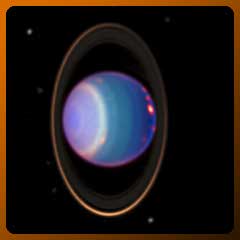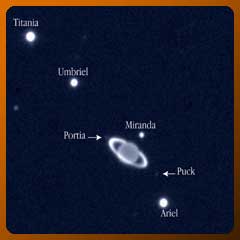You are seeing this message because you are using an out-of-date browser.
Please click here for more information.
Uranus from Hubble

Image courtesy of: Hubble Space Telescope
Uranus's Tilt in 1998

Image courtesy of: Hubble Space Telescope
We have seasons here on Earth because our planet is tilted on its axis. As our planet makes its way around the Sun, the tilt of Earth means that different amounts of our planet receive more direct sunlight than others. When the northern hemisphere of Earth is tilted towards the Sun, it has summer and the southern hemisphere has winter. Six months later, the weather is reversed.
Uranus also has "seasons", but the extreme tilt of the planet makes the seasons vary widely. The high degree of tilt also gives us a much different view of the planet depending on when we see it during its eighty-four year long trip around the Sun.
When Voyager arrived at Uranus in 1986, the planet's pole was facing the sun. In 1998, the Hubble Space Telescope took this picture of Uranus and its rings and the tilt has changed.
Uranus in 2002

Image courtesy of: European Southern Observatory
Uranus's Tilt in 2002

Image courtesy of: European Southern Observatory
In December of 2002, the European Southern Observatory took this amazing picture along with six of the giant planet's moons. Not only is this an excellent picture of the planet, along with its rings and several of its moons, it also shows that in a relatively short period of time, the tilt of the planet seems to have changed.
Actually, the tilt of the planet has not changed, but its position relative to Earth and the Sun has changed, so we see a very different view than we had just a few short years before.
This entire site copyright © 2003 Astronomy for Kids - all rights reserved

